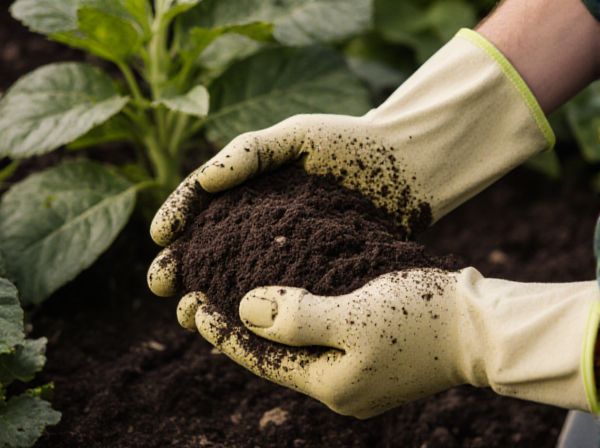
Mature compost vs Immature compost Illustration
Mature compost is fully decomposed organic matter, rich in nutrients and stable, making it safe to use for soil amendment without harming plants. Immature compost contains partially decomposed materials that may harbor pathogens, weed seeds, and phytotoxic substances, potentially damaging plant growth. Proper curing ensures compost reaches maturity, enhancing soil health and promoting sustainable gardening.
Table of Comparison
| Feature | Mature Compost | Immature Compost |
|---|---|---|
| Appearance | Dark brown, crumbly, soil-like texture | Lighter color, clumpy, uneven texture |
| Smell | Earthy, pleasant odor | Sharp, ammonia-like or sour smell |
| Temperature | Ambient, stable temperature | Elevated temperature due to ongoing microbial activity |
| pH Level | Neutral to slightly alkaline (6.5-8) | Variable, often acidic or alkaline due to active decomposition |
| Nutrient Content | Balanced and readily available nutrients | Unstable nutrient levels, potential nitrogen drawdown |
| Microbial Activity | Low microbial activity, stable ecosystem | High microbial activity, ongoing decomposition |
| Plant Toxicity | Safe for plants, promotes healthy growth | Can inhibit plant growth due to phytotoxic compounds |
| Use in Gardening | Ideal as soil amendment and fertilizer | Not recommended until fully decomposed |
Understanding Mature vs Immature Compost
Mature compost is characterized by a dark, crumbly texture, earthy smell, and stable nutrient content, indicating complete organic matter decomposition, while immature compost often has a sour odor, visible unchanged materials, and can harm plants due to high ammonia levels. Understanding the differences is crucial for optimizing soil health and preventing crop damage, as mature compost promotes beneficial microbial activity and nutrient availability. Using immature compost can lead to nitrogen immobilization and phytotoxicity, reducing plant growth and soil fertility.
Key Differences in Composition
Mature compost exhibits a balanced carbon-to-nitrogen ratio, typically around 10:1 to 15:1, and contains stable humic substances, indicating full decomposition and nutrient availability. Immature compost retains higher levels of volatile organic compounds, elevated ammonia, and pathogens, reflecting incomplete organic matter breakdown and potential phytotoxicity. Key compositional differences include reduced moisture content and diminished labile organic matter in mature compost, enhancing its suitability for soil amendment and plant growth.
Signs of Mature Compost
Mature compost is characterized by a dark brown or black color, a crumbly texture, and an earthy aroma, indicating complete decomposition. It no longer generates heat, signifying microbial activity has stabilized, and it contains no visible food particles or recognizable organic material. The pH of mature compost is neutral to slightly acidic, typically ranging from 6 to 8, making it safe and beneficial for soil application.
Identifying Immature Compost
Immature compost is characterized by a sour or ammonia-like odor, uneven texture, and visible undecomposed organic matter, indicating incomplete microbial breakdown. Its pH often remains acidic or unstable, and it may cause phytotoxicity, hindering plant growth if applied directly to soil. Reliable identification relies on temperature monitoring during composting and germination tests to ensure maturity and safety for agricultural use.
Nutrient Availability in Each Type
Mature compost contains stabilized organic matter with readily available nutrients such as nitrogen, phosphorus, and potassium, promoting healthy plant growth and improving soil fertility. Immature compost, however, has incomplete decomposition and may still harbor phytotoxic compounds and unstable nutrient levels, which can inhibit seed germination and plant development. The nutrient availability in mature compost supports balanced microbial activity and efficient nutrient cycling, whereas immature compost may lead to nutrient immobilization and nitrogen deficiency in the soil.
Effects on Plant Health and Growth
Mature compost enhances plant health by providing balanced nutrients, improving soil structure, and promoting beneficial microbial activity, which supports robust root development and disease resistance. Immature compost, containing phytotoxins and unstable organic matter, can inhibit seed germination, stunt growth, and increase susceptibility to pathogens. Using mature compost consistently results in healthier plants with higher yields and improved stress tolerance.
Application Timing in Your Garden
Mature compost is best applied during planting or as a top dressing since it is stable, nutrient-rich, and safe for plants, promoting healthy growth without the risk of root damage. Immature compost should be avoided in direct application because it can contain phytotoxic compounds and compete with plants for nitrogen, potentially stunting growth. Timing the application of compost based on its maturity ensures optimal nutrient availability and soil improvement for your garden.
Risks of Using Immature Compost
Using immature compost poses significant risks such as the presence of phytotoxic substances that can inhibit seed germination and plant growth. Immature compost may harbor pathogens and weed seeds, increasing the likelihood of crop diseases and infestations. Furthermore, incomplete decomposition in immature compost can lead to nitrogen immobilization, resulting in nutrient deficiencies for plants.
How to Properly Mature Your Compost
Properly maturing your compost requires maintaining an optimal temperature range of 130-160degF (54-71degC) for several weeks to ensure pathogen destruction and nutrient stabilization. Frequent turning aerates the pile, promoting microbial activity and preventing anaerobic conditions that lead to immature compost with phytotoxic compounds. Monitoring moisture levels at 40-60% and allowing the compost to cure until it reaches a dark, crumbly texture ensures a fully matured, nutrient-rich amendment ideal for garden use.
Best Practices for Compost Quality Control
Mature compost exhibits a dark, crumbly texture with a pleasant earthy smell, indicating optimal microbial activity and nutrient stability, while immature compost often retains recognizable feedstock and emits ammonia or sour odors. Best practices for compost quality control involve regular temperature monitoring to ensure thermophilic phases reach 55-65degC for pathogen kill-off and periodic moisture checks maintaining 40-60% content for effective microbial decomposition. Implementing aeration strategies such as turning piles every 3-7 days promotes oxygen supply, preventing anaerobic conditions that lead to immature compost and potential phytotoxicity.
Mature compost vs Immature compost Infographic

 gardendif.com
gardendif.com